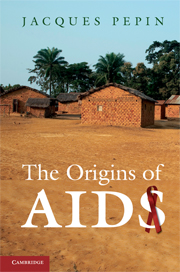Book contents
- Frontmatter
- Contents
- Figures, maps and table
- Acknowledgements
- Abbreviations
- Note on terminology
- Introduction
- 1 Out of Africa
- 2 The source
- 3 The timing
- 4 The cut hunter
- 5 Societies in transition
- 6 The oldest trade
- 7 Injections and the transmission of viruses
- 8 The legacies of colonial medicine I
- 9 The legacies of colonial medicine II
- 10 The other human immunodeficiency viruses
- 11 From the Congo to the Caribbean
- 12 The blood trade
- 13 The globalisation
- 14 Assembling the puzzle
- 15 Epilogue
- References
- Appendix Classification of retroviruses
- Index
Appendix - Classification of retroviruses
Published online by Cambridge University Press: 05 June 2012
- Frontmatter
- Contents
- Figures, maps and table
- Acknowledgements
- Abbreviations
- Note on terminology
- Introduction
- 1 Out of Africa
- 2 The source
- 3 The timing
- 4 The cut hunter
- 5 Societies in transition
- 6 The oldest trade
- 7 Injections and the transmission of viruses
- 8 The legacies of colonial medicine I
- 9 The legacies of colonial medicine II
- 10 The other human immunodeficiency viruses
- 11 From the Congo to the Caribbean
- 12 The blood trade
- 13 The globalisation
- 14 Assembling the puzzle
- 15 Epilogue
- References
- Appendix Classification of retroviruses
- Index
Summary
For readers unfamiliar with virology, this section reviews a few concepts, which are summarised in the table. HIV-1 and HIV-2 are the two human ‘retroviruses’ that cause AIDS. To replicate, retroviruses transcribe RNA into DNA, which is then integrated into the DNA genome of the human host cells. This process is the reverse of what normally happens (DNA transcripted into RNA), hence their name. Retroviruses are further subdivided into ‘lentiviruses’ (HIV-1 and HIV-2), ‘oncoviruses’ (HTLV-I, the first retrovirus isolated from humans, which does not cause AIDS but sometimes cancer or paraplegia) and ‘spumaviruses’ (not pathogenic).
Of course, the pandemic is caused by HIV-1. HIV-2 differed enough, genetically, from HIV-1 to be considered a distinct virus. It remained confined to West Africa, is less transmissible and less pathogenic than HIV-1 and slowly disappeared while HIV-1 spread throughout the world. HIV-1 infection is 100 times more common than HIV-2; when authors use the term HIV, in practice it generally means HIV-1.
- Type
- Chapter
- Information
- The Origins of AIDS , pp. 282 - 283Publisher: Cambridge University PressPrint publication year: 2011



